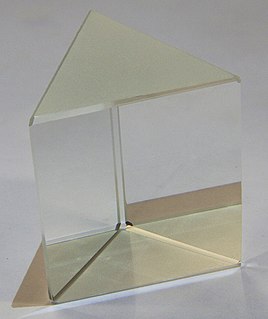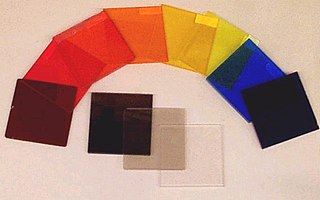Related Research Articles

Optical rotation, also known as polarization rotation or circular birefringence, is the rotation of the orientation of the plane of polarization about the optical axis of linearly polarized light as it travels through certain materials. Circular birefringence and circular dichroism are the manifestations of optical activity. Optical activity occurs only in chiral materials, those lacking microscopic mirror symmetry. Unlike other sources of birefringence which alter a beam's state of polarization, optical activity can be observed in fluids. This can include gases or solutions of chiral molecules such as sugars, molecules with helical secondary structure such as some proteins, and also chiral liquid crystals. It can also be observed in chiral solids such as certain crystals with a rotation between adjacent crystal planes or metamaterials.

A waveplate or retarder is an optical device that alters the polarization state of a light wave travelling through it. Two common types of waveplates are the half-wave plate, which shifts the polarization direction of linearly polarized light, and the quarter-wave plate, which converts linearly polarized light into circularly polarized light and vice versa. A quarter-wave plate can be used to produce elliptical polarization as well.

Birefringence is the optical property of a material having a refractive index that depends on the polarization and propagation direction of light. These optically anisotropic materials are said to be birefringent. The birefringence is often quantified as the maximum difference between refractive indices exhibited by the material. Crystals with non-cubic crystal structures are often birefringent, as are plastics under mechanical stress.

The milkfish is the sole living species in the family Chanidae. However, there are at least five extinct genera from the Cretaceous. The repeating scientific name (tautonym) is from Greek khanos.

An optical prism is a transparent optical element with flat, polished surfaces that are designed to refract light. At least one surface must be angled — elements with two parallel surfaces are not prisms. The traditional geometrical shape of an optical prism is that of a triangular prism with a triangular base and rectangular sides, and in colloquial use "prism" usually refers to this type. Some types of optical prism are not in fact in the shape of geometric prisms. Prisms can be made from any material that is transparent to the wavelengths for which they are designed. Typical materials include glass, acrylic and fluorite.

Mantis shrimp, or stomatopods, are carnivorous marine crustaceans of the order Stomatopoda, branching from other members of the class Malacostraca around 340 million years ago. Mantis shrimps typically grow to around 10 cm (3.9 in) in length, while a few can reach up to 38 cm (15 in). A mantis shrimp's carapace covers only the rear part of the head and the first four segments of the thorax. Varieties range in colour from shades of brown to vivid colours, with more than 450 species of mantis shrimp being known. They are among the most important predators in many shallow, tropical and subtropical marine habitats. However, despite being common, they are poorly understood, as many species spend most of their lives tucked away in burrows and holes.

An optical coating is one or more thin layers of material deposited on an optical component such as a lens or mirror, which alters the way in which the optic reflects and transmits light. One type of optical coating is an anti-reflective coating, which reduces unwanted reflections from surfaces, and is commonly used on spectacle and camera lenses. Another type is the high-reflector coating, which can be used to produce mirrors that reflect greater than 99.99% of the light that falls on them. More complex optical coatings exhibit high reflection over some range of wavelengths, and anti-reflection over another range, allowing the production of dichroic thin-film filters.

An optical filter is a device that selectively transmits light of different wavelengths, usually implemented as a glass plane or plastic device in the optical path, which are either dyed in the bulk or have interference coatings. The optical properties of filters are completely described by their frequency response, which specifies how the magnitude and phase of each frequency component of an incoming signal is modified by the filter.
Plate readers, also known as microplate readers or microplate photometers, are instruments which are used to detect biological, chemical or physical events of samples in microtiter plates. They are widely used in research, drug discovery, bioassay validation, quality control and manufacturing processes in the pharmaceutical and biotechnological industry and academic organizations. Sample reactions can be assayed in 1-1536 well format microtiter plates. The most common microplate format used in academic research laboratories or clinical diagnostic laboratories is 96-well with a typical reaction volume between 100 and 200 µL per well. Higher density microplates are typically used for screening applications, when throughput and assay cost per sample become critical parameters, with a typical assay volume between 5 and 50 µL per well. Common detection modes for microplate assays are absorbance, fluorescence intensity, luminescence, time-resolved fluorescence, and fluorescence polarization.
A stereo display is a display device capable of conveying depth perception to the viewer by means of stereopsis for binocular vision.

Ellipsometry is an optical technique for investigating the dielectric properties of thin films. Ellipsometry measures the change of polarization upon reflection or transmission and compares it to a model.

Loose connective tissue is a category of connective tissue which includes areolar tissue, reticular tissue, and adipose tissue. Loose connective tissue is the most common type of connective tissue in vertebrates. It holds organs in place and attaches epithelial tissue to other underlying tissues. For example, it forms telae, such as the tela submucosa and tela subserosa, which connect mucous and serous membranes to the muscular layer. It also surrounds the blood vessels and nerves. Cells called fibroblasts are widely dispersed in this tissue; they are irregular branching cells that secrete strong fibrous proteins and proteoglycans as an extracellular matrix. The cells of this type of tissue are generally quite separated by a gelatinous substance primarily made up of collagenous and elastic fibers.

Pelagic fish live in the pelagic zone of ocean or lake waters – being neither close to the bottom nor near the shore – in contrast with demersal fish that do live on or near the bottom, and reef fish that are associated with coral reefs.

A polarizer or polariser is an optical filter that lets light waves of a specific polarization pass through while blocking light waves of other polarizations. It can filter a beam of light of undefined or mixed polarization into a beam of well-defined polarization, that is polarized light. The common types of polarizers are linear polarizers and circular polarizers. Polarizers are used in many optical techniques and instruments, and polarizing filters find applications in photography and LCD technology. Polarizers can also be made for other types of electromagnetic waves besides visible light, such as radio waves, microwaves, and X-rays.
A Lyot filter, named for its inventor Bernard Lyot, is a type of optical filter that uses birefringence to produce a narrow passband of transmitted wavelengths. Lyot filters are often used in astronomy, particularly for solar astronomy.

An atomic line filter (ALF) is a more effective optical band-pass filter used in the physical sciences for filtering electromagnetic radiation with precision, accuracy, and minimal signal strength loss. Atomic line filters work via the absorption or resonance lines of atomic vapors and so may also be designated an atomic resonance filter (ARF).

Many researchers have found the evolution of the eye attractive to study because the eye distinctively exemplifies an analogous organ found in many animal forms. Simple light detection is found in bacteria, single-celled organisms, plants and animals. Complex, image-forming eyes have evolved independently several times.

Starlight is the light emitted by stars. It typically refers to visible electromagnetic radiation from stars other than the Sun, observable from Earth at night, although a component of starlight is observable from Earth during daytime.

Vision is an important sensory system for most species of fish. Fish eyes are similar to the eyes of terrestrial vertebrates like birds and mammals, but have a more spherical lens. Birds and mammals normally adjust focus by changing the shape of their lens, but fish normally adjust focus by moving the lens closer to or further from the retina. Fish retinas generally have both rod cells and cone cells, and most species have colour vision. Some fish can see ultraviolet and some are sensitive to polarised light.
Fiber-optic filter is an optical fiber instrument used for wavelength selection, which can select desired wavelengths to pass and reject the others. It is Widely used in DWDM systems dynamic wavelength selection, DWDM signal separation, optical performance monitoring, field tunable optical noise filtering and optical amplifier noise suppression, etc. Optical multiplexers (couplers) makes different wavelength coupling into an optical fiber and different wavelength carries different information. At the receiving end, if you want to separate desired wavelengths from optical fiber, it is necessary to use optical filter.
References
- ↑ Froese, Rainer. "Adipose eyelid". FishBase Glossary. Retrieved 2011-12-11.
- ↑ "Teleost Anatomy Ontology: Adipose eyelid". National Center for Biomedical Ontology. Retrieved 2011-12-11.
- ↑ "Smithsonian Tropical Research Institute - Shorefishes of the Tropical Eastern Pacific". Smithsonian Tropical Research Institute. Archived from the original on 2010-06-25. Retrieved 2011-12-11.
- 1 2 3 4 5 Chang, C.-H.; Chiao, C.-C.; Yan, H. Y. (2009). "The structure and possible functions of the milkfish Chanos chanos adipose eyelid". Journal of Fish Biology. 75 (1): 87–99. doi:10.1111/j.1095-8649.2009.02266.x. PMID 20738484.
- ↑ Rangaswamy, C. P. "On the Development of Adipose Eyelids in the Fry of Liza Microlepis and L. Parsia". Indian Journal of Fisheries: 223–6.
- 1 2 3 4 Stewart, Kenneth W. (1962). "Observations on the Morphology and Optical Properties of the Adipose Eyelid of Fishes". Journal of the Fisheries Research Board of Canada. 19 (6): 1161–2. doi:10.1139/f62-076.
- ↑ Denton, E. J.; Nicol, J. A. C. (1965). "Polarization of light reflected from the silvery exterior of the bleak, Alburnus alburnus". Journal of the Marine Biological Association of the United Kingdom. 45 (3): 705–9. doi:10.1017/S0025315400016532. Archived from the original on 2012-07-14.